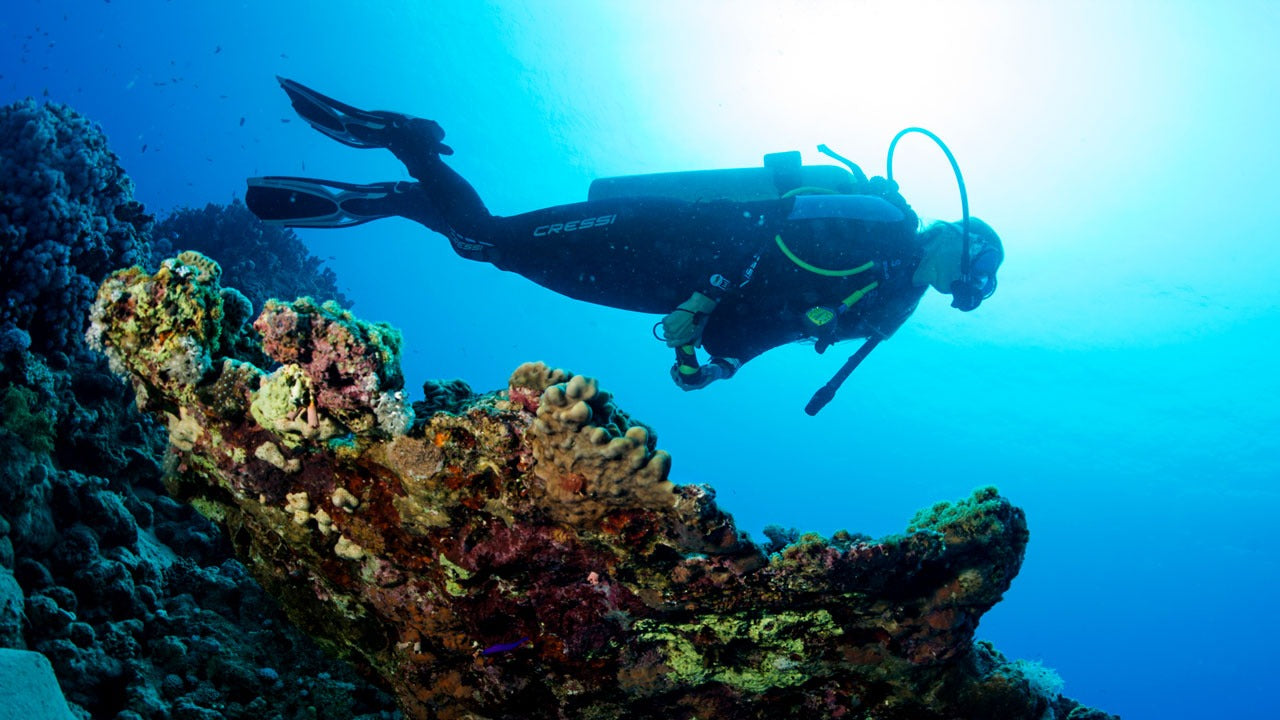End of the Year Divers Digest: the Highlights of 2018

2018 is coming to an end, but before we say goodbye to this year, let’s take a moment to look back at some of the most exciting diving-related news from the past 12 months.
World Records
2018 has brought us three diving-related Guinness World Records - for the longest open water dive in cold water, the oldest male scuba diver, and the longest underwater human chain by female scuba divers.
The first record we are going to look at is the longest open water dive in cold water. It was set by a Turkish diver Cem Karabay on Tuesday, April 24, 2018. Karabay spent 30 hours and 20 minutes in the Aegean Sea at the Gokceada Island Marine Park at a depth of 18ft (6m). With such an impressive performance, he doubled the previous cold water endurance record held by Norwegian Nils-Roar Selnes, which stood at 15 hours and 10 minutes.
It is worth noting that this is not the first Guinness World Record set by Cem Karabay. In 2011 he set the world record for the longest dive in a controlled environment, which lasted 192 hours, 19 minutes, and 19 seconds, and in 2016 Karabay smashed the record for the longest open-water scuba dive by staying under for 142 hours, 42 minutes and 42 seconds.
Another awe-inspiring record was set by a British diver Ray Woolley. The men broke his own world record as the oldest male scuba diver on August 28th, when he turned 95 and plunged to a depth of 130ft (40.6m) for 44 minutes. The dive took place in Cyprus on the wreck of Zenobia. Woolley, who has been an active diver for 58 years, commenting on his motivation to dive when other people of a similar age are happier with a much more relaxed lifestyle stated:
“I am trying to prove to myself, and I hope to other people, that exercise, especially when you are getting to around my age, is most important to do.”
Last but not least in our lineup of this year’s diving-related Guinness World Records is a record for the longest underwater human chain by female scuba divers. It was set by 84 women divers at the house reef of Divetech Grand Cayman. The event took place on PADI Women’s Dive Day, and in addition to setting a record raised more than US$3,000 for the Breast Cancer Foundation. You can check out a video of the world record event below.
Reefs and Wrecks
2018 has brought quite a few amazing new dive sites to add to your bucket list.
Just this October, the state of California opened the Emerald Bay Maritime Heritage Trail - an underwater showcase of Lake Tahoe’s historic sunken watercraft and barges. The bay is the final resting place of several recreational boats, launches, and barges used on the lake during the early 20th century. These boats were likely intentionally scuttled (sunk) in the 1950s when they outlived their usefulness. Nowadays, they serve as reminders of the golden age of recreation in Tahoe. This collection is the largest, most diverse group of sunken small watercraft of its kind, in their original location, known to exist in the nation.
Another great find for the wreck diving lovers is a 400-year-old, virtually intact trading ship, found on September 3, 2018, off the coast of the Portuguese town of Cascais. The vessel is thought to have sunk between 1575 and 1625 while en route to Portugal from India. It is laden with Chinese ceramics, bronze cannons, and cowrie shells - all in excellent condition. The wreck offers great opportunities for discovery and artifact recovery since it is lying at the shallow depth of 40ft (12m). The find is considered to be the most significant in Portuguese waters.
Speaking of wrecks with hidden jewels, divers in Lake Huron have recently discovered the wreckage of a ship named the Manasoo with an amazing surprise inside - a 1927 Chevrolet Coupe. Despite spending 90 years 200 feet (61 meters) below the surface of Georgian Bay, both the ship and the automobile are in excellent condition. The bow of the vessel is pointing up; the pilothouse, ship’s wheel, and lifeboats are all unscathed except for the invasive zebra and quagga mussels that almost completely cover the surfaces. The experts at the Great Lakes Shipwreck Preservation Society say it’s unlikely that the ship will ever be brought to the surface - but they hope to retrieve the car and display it in a local museum.

While all of the finds mentioned above are, no doubts, amazing, when it comes to shipwrecks and treasure, it does not get much bigger than the San Jose, a Spanish galleon found off the coast of Colombia. The unfortunate vessel sank after a battle with British Navy warships on June 8, 1708, and all 600 members of her crew were lost. What makes the San Jose so astounding though is the scale of its treasure, estimated to be worth up to US$16.75 billion in gold, emeralds, and silver. Unfortunately, the wreck is not available for divers to explore. The ship was found in more than 2,000ft (600m) of water, and its precise location remains a state secret.
As for the reef divers out there, you can now visit the largest purpose-built reef habitat in the Southern Hemisphere. The new reef, called King Reef, is located 3.5 nautical miles north of Exmouth in Western Australia. It comprises 58 concrete and steel modules ranging in height from 1 to 10 meters (33 feet) laid out across two acres of the ocean floor at a depth of 18 meters (60 feet). These structures will provide a habitat volume equal to that of 11 Olympic-size swimming pools. The reef is readily accessible from local boat ramps.
Books and Movies
For many divers, the next best thing to being underwater is talking about being underwater. And there is no better occasion for this than when sitting enjoying a meal together with like-minded friends.
With this thought in mind, co-authors Simon Pridmore and David Strike have created “Dining with Divers: Tales from the Kitchen Table”. The book invites you to listen to stories and try dishes served up by a gathering of some of the great and the good of the scuba diving world. Explorers, record-breakers, innovators, designers, entrepreneurs, and raconteurs all compete for your attention and taste buds in this first volume of a unique series of diving story cookbooks. The dishes they propose vary from cookouts to curries, from Thai salad to Flemish stew and from jellied eels to vegan cupcakes. The personal accounts of underwater adventure range from shipwreck discoveries to iceberg exploration and encounters with big animals.
For more info, check the book out on Amazon.
If you are less into cooking and more into maritime history, the book “Diving For Treasure: Discovering History in the Depths” by Vic Verlinden and Stefan Panis, might be just right for you. The book includes stories about 17 wrecks that contained treasure in one form or another. Each entry provides such details as a brief history of the vessel and the means of its demise, enhanced by a modern diving account and photographs. The authors are both diving experts and in addition to the historical pictures they have added their own photography to convey to the reader the challenges of the dives undertaken.
You can find the book on Amazon.
Finally, if you are interested in learning more about non-technical diving skills and dive safety, you may want to check out a new, free eBook by Gareth Lock. Lock has spent the last eight years researching diving incidents and applying the science of human factors to diving. He now runs a globally-unique training and consultancy company that focuses on teaching divers and diving instructors how to become high-performance divers and dive teams by developing their non-technical and human factors skills via eLearning and face-to-face programs.
This 60-plus-page free eBook is an extract of three chapters from the full book which will be published in February/March 2019. The eBook mixes theory with practical advice and real-life examples of various diving incidents.
As for the diving-related movies of this year, you should check out the beautiful documentary “Dolphin Man”. The film focuses on a famed freediver Jacques Mayol, his compelling life journey, and the experience of freediving itself. “Dolphin Man” includes contemporary underwater photography of the world’s leading freedivers as well as the stories of Mayol’s closest friends and rare footage of him.
For more info about the documentary, check out the trailer below or go to dolphinmanfilm.com.
Technology
In our technology section, we are going to highlight 3 different models of dive computers released this year and a new underwater navigation and communication system.
Let’s start with the Teric - the first dive watch by Shearwater Research.
This computer has a rich, full-color AMOLED screen, rechargeable battery, and includes a wireless inductive charger. It also comes with a new freediving mode that has programmable sampling rates, configurable haptic and audible alarms, and improved ascent and descent rate indicators. As with the Perdix AI and the NERD 2 dive computers, the Teric can connect with up to two wireless tank pressure transmitters.
Like all other Shearwater dive computers, this device is a multigas trimix dive computer that can be used for Open-Circuit and Closed Circuit diving with a fixed ppO2. The Teric is also fully integrated with the free Shearwater Cloud multi-platform dive logging service.
The Teric retails for US$1095, and the transmitter for US$346.

One more dive computer we are going to look at is the i770R by AquaLung.
The i770R sports an ultra-bright TFT color screen as well as wireless Bluetooth connectivity in a robust and compact design. You can monitor all your information with the easy-to-use interface and intuitive three-button navigation. Standard features include a rechargeable lithium battery, three-axis full-tilt compass, easy three-button navigation, multiple gas capability, and four operating modes (Air, Nitrox, Gauge, and Freedive).
The i770R also lets you wirelessly manage your dive data and settings on your mobile device via Bluetooth.
The i770R retails for US$899.

Moving on, let’s look at the new impressive development in the area of dive safety and signaling. A company called UWIS has created an underwater navigation and communication system that can accurately track up to 100 divers simultaneously over an area spanning 800 meters / 2624 feet to a depth of 150m / 492ft.
The system consists of four main components:
- A diver-held tablet with navigation and communication capability.
- A transmitter mounted to the diver’s tank which communicates with the tablet via Bluetooth.
- A transmitter buoy equipped with GPS and WIFI.
- A browser-operated surface interface.
The system works by relaying data from the diver’s transmitter to the surface via the buoy. With this new system, divers locations are able to be tracked to within a few meters, and both the diver and the surface monitor can communicate via a series of preset messages.
The UWIS is the perfect companion for commercial and recreational diving missions and helps plan and execute safe dives.
You can find out more about the UWIS system here.
Last but not least, here are some of the most popular articles of the year from our blog. Enjoy!




